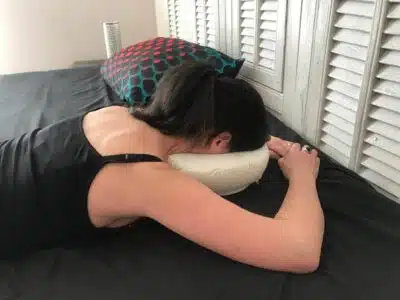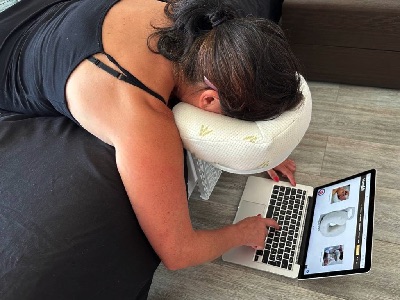MassMe macular hole cushion: your ideal recovery companion
The journey to recovery after a macular hole or retinal detachment surgery can be challenging. Ensuring that you have the right support system is crucial for a smooth healing process. The MassMe vitrectomy cushion has been designed with this need in mind, offering a versatile and comfortable solution to help you maintain the necessary head position post-surgery. From sitting at your desk to lying in bed, this innovative device allows you to live almost normally while facilitating a serene convalescence.
Comfort through seamless integration
Supporting various daily activities
The MassMe macular hole cushion is not just an ordinary cushion. Its design lets you seamlessly integrate it into your everyday life. Whether you’re sitting at your desk, eating, reading, or even wearing glasses, the wide-open design ensures continual proper healing without compromising on comfort. You no longer need to depend solely on specialized chairs; this cushion travels with you and adapts to different environments.
Versatile design for ease of use
A day-and-night ally
Your comfort is paramount during recovery. The cushion’s adaptable frame supports both lying down and sitting up positions, ensuring that you remain comfortable all day and night. Its practicality allows you to continue with most of your regular activities without any hassle. Watch this video to see how to install your post-vitrectomy cushion, demonstrating how easily it fits into your lifestyle.
Three adaptive positions
The MassMe macular hole cushion provides three distinct positions to cater to various needs. You can lie on your bed with the cushion off the mattress, lie on the bed with it on the mattress, or sit in a chair with the cushion on the table. This flexibility ensures that you always find a comfortable way to maintain the required posture for recovery.
- 2 lying positions




- 1 sitting position


Durable and multifunctional
Unlike rental equipment, the MassMe cushion is an investment in long-term comfort. Beyond its primary function during recovery, it serves other purposes such as relaxation, massages, and naps. Should a recurrence or second surgery be needed, having the cushion on hand ensures continued support and comfort. Additionally, the wide-opening design allows good ventilation, making it easy to breathe, talk, and look around, whether or not you’re wearing glasses.

Watch this video to see how to install your post-macular hole cushion
Versatile design for ease of use
3 adaptive positions : The MassMe macular hole cushion provides three distinct positions to cater to various needs. You can lie on your bed with the cushion off the mattress, lie on the bed with it on the mattress, or sit in a chair with the cushion on the table. This flexibility ensures that you always find a comfortable way to maintain the required posture for recovery.
Durable and multifunctional Better than renting macular hole recovery equipment, your MassMe cushion will be useful after your recovery for your relaxation: massage, relaxation, nap and in case of recurrence or second eye surgery.
Ready to use No assembly time, no fixing required, it is immediately ready for all your situations.
Easy to use No floor space required, can be installed and adjusted on all your supports: bed, table, desk….
Ergonomic Your spine is perfectly aligned. The wide-opening cushion allows good ventilation for breathing, talking, looking with or without glasses.
Comfortable Memory foam with Oeko-Tex® bamboo cover is comfortable and pleasant to the skin.
Hygiene New equipment with a removable, machine-washable, anti-allergic and anti-bacterial bamboo textile cover.
Compact & transportable The device has a small footprint with an integrated carrying handle and weighs only 1.2 kg.
Patented and made in France 100% designed, manufactured and assembled in France with recyclable materials
Express delivery We ship daily for home delivery in Europe and worldwide.
Reimbursement Some mutual insurance companies cover all or part of your purchase.


Reasons to choose the MassMe cushion
Preservation of well-being
Maintaining the ‘bubble position’ after surgery is vital. However, this often uncomfortable position is made significantly easier with the MassMe macular hole cushion. It supports social interactions, eating, mobility, vision, and sleep, thus preserving your well-being throughout the recovery period.
Proper head alignment
During recovery from macular hole or retinal detachment surgery, keeping your head correctly aligned is crucial. The MassMe cushion, manufactured in France, is specifically designed to ensure your head remains parallel to the ground, promoting better healing outcomes.
Accelerated recovery process
The cushion’s ergonomic design alleviates strain on your neck, shoulders, and spine, which can speed up muscle flexibility restoration. This effective relief aids a faster overall recovery by reducing discomfort and stress on your body parts.
Preparedness for future surgeries
In about 10% of macular hole cases, follow-up surgeries on the alternate eye may become necessary. Having the MassMe cushion ensures that you are well-prepared for any additional procedures. Not only does it save you money by eliminating the need for rentals, but it also guarantees that you have suitable equipment ready for another recovery phase.

Understanding macular hole: symptoms, causes, and treatment
A macular hole might sound alarming, but with modern advancements, it’s a condition you can understand and address. Awareness about this issue is crucial, especially as we age and our eye health evolves. MassMe will guide you through the journey of understanding what a macular hole is, its causes, symptoms, surgical treatments, and the healing process.
What is a macular hole?
The term “macular hole” refers to a small break or defect that occurs in the macula, which is an essential part of the retina located at the back of the eye. The macula is responsible for sharp, central vision necessary for activities like reading, driving, and recognizing faces. When a full-thickness defect appears in this area, it can lead to significant visual impairment.
This condition generally affects people over 60 years old and can progress from minor to severe if not addressed timely. Because the macula is vital for central vision, any disruption can drastically impact daily life.
Symptoms of a macular hole
Identifying the symptoms early can make a difference in preserving your vision. One of the first signs is usually a gradual decline in the clarity of central vision. Objects may appear blurred and distorted, making it difficult to perform tasks requiring detailed sight.
Other common symptoms include a dark spot or a missing area in the central vision, straight lines appearing wavy or bent, and needing more light to see clearly. These changes typically occur in one eye, though both eyes can eventually be affected.
Causes of a macular hole
There are several causes behind the formation of a macular hole. The most common cause is age-related changes in the vitreous, the gel-like substance inside your eye. As we age, the vitreous can shrink and pull away from the retina. If it adheres too strongly to the foveal retina (the center of the macula), it can create a tear.
Other factors leading to macular holes include eye injuries, detached retinas, severe myopia, and certain diseases like diabetic retinopathy. Each of these conditions can put stress on the macula, increasing the risk of developing a defect.
Macular hole surgery
Vitrectomy
Surgery is often the recommended course of action for treating a macular hole. The most common procedure is a vitrectomy. During a vitrectomy, an ophthalmologist removes the vitreous gel pulling on the retina and replaces it with a gas bubble. This gas bubble acts as a temporary bandage, holding the edges of the macular hole together so it can heal.
The success rate of this surgery is quite high, and many people regain much of their lost vision. However, the recovery process requires following specific post-surgery instructions meticulously.
Post-operative care
Post-operative care is critical to ensuring a successful outcome. One of the unique aspects of recovering from macular hole surgery involves positioning. Patients are advised to keep their head face-down for an extended period, often up to two weeks. This position helps the gas bubble stay in place, pressing against the macula to aid healing.
Additionally, patients need to avoid air travel and high-altitude locations while the gas bubble is present in the eye, as changes in altitude can increase pressure and affect the healing process. Regular follow-up visits with an ophthalmologist will monitor the progress and check if further treatment is required.
Healing and vision improvement
The path to restoring vision after macular hole surgery can be slow but rewarding. Initially, your vision will be blurry due to the presence of the gas bubble. As the bubble slowly absorbs and is replaced by natural eye fluids, your vision will gradually improve.
Full recovery could take several months, during which the retina tissues heal completely. In many cases, patients report a substantial improvement in their ability to see clearly once the healing process concludes. Despite some residual imperfections, such as slight distortions or minor blurriness, the overall visual function tends to enhance significantly.





